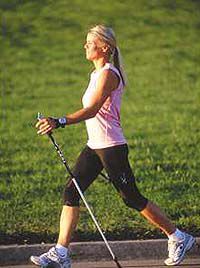For years, professional athletes and non-athletes alike have relied upon cross-country skiing to build stamina, muscle strength, cardiovascular health, and improve the overall tone of the body.
In the 20th century, cross-country skiing athletes in Finland developed an idea that could replicate the motions and benefits of cross-country skiing . Without the snow. They used this form of exercise to train in the summer. Eventually an enterprising Scandinavian company marketed the idea to a broad spectrum of athletes – calling the exercise Nordic Walking – and a new training routine was born.
Nordic Walking, which involves the use of specially-designed poles held in each hand, quickly caught on in the fitness world, but also appealed to regular folks looking for a low-impact, but effective workout.
Nordic Walking takes fitness walking to the next level by building postural endurance, upper and lower body strength, and aerobic capacity. Walkers use poles to engage the upper body and redistribute weight bearing to the lower extremity, which increases the cardiovascular benefits and caloric demands of walking.
A study by the Cooper Institute in Dallas, showed that walking with poles burned more calories, increased oxygen consumption, and can be up to 46 percent more efficient than normal walking. What’s more, walking with poles as little as 30 minutes a day, three times a week, can help lower blood pressure, increase oxygen consumption by 25 percent, reduce cholesterol, and help to relieve back, shoulder and neck pain.
Any person of any age can benefit from the health enhancing benefits of Nordic Walking. Health-care professionals say Nordic Walking is a viable low-impact solution for those who can no longer take the steady pounding of running or jogging, but desire similar benefits. Even runners use Nordic Walking as a cross-training tool to develop their upper body, and also during rehab from an injury.
Nordic Walking is quickly becoming the hottest exercise around. But to reap the benefits, it’s important to follow some key techniques.
•Start with the right equipment. Manufacturers make poles that feature adjustable and fixed length models, quick-release trigger straps, four different types of removable rubber tips (including studded rubber), carbide tips, and aluminum and carbon construction.
•Nordic Walking is a simple enhancement of normal arm swing when walking. The pole tips remain behind, pointing diagonally backwards at all times.
•Holding the grip lightly, the hand swings forward from the shoulder to allow the rubber tip to meet the ground or pavement.
•The hands are opened slightly to allow the poles to swing forward – the poles are not gripped, but swing from the wrist straps.
•This exercise is best engaged wearing workout apparel that supports the joints, ligaments and tendons, like CW-X Conditioning Wear, which also wicks moisture from the skin, keeping the body dry and comfortable.
Four legs are better than two

